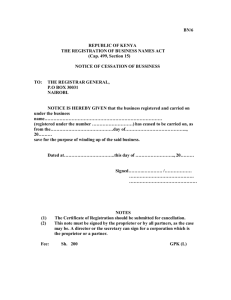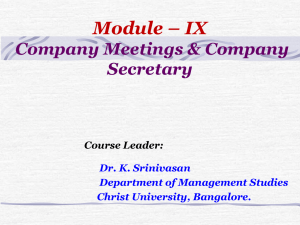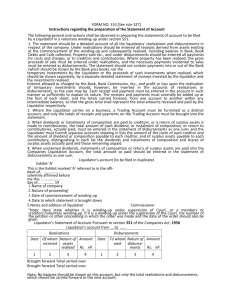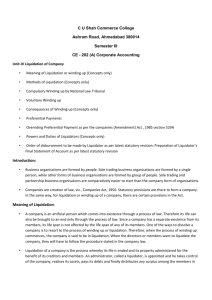Winding up of companies
advertisement
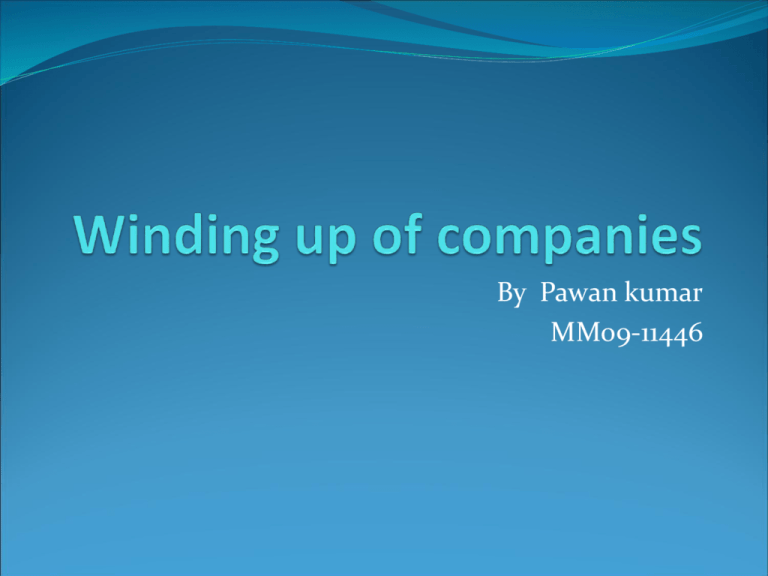
By Pawan kumar MM09-11446 1 Winding Up. Winding up of a company is the process whereby its life is ended and its property administered for the benefit of its creditors and members. Modes of Winding up - A company may be would up in any one of the three ways, (I) compulsory winding up ie., by Court (s.433) (Ii) voluntary winding up; (s 484) (ii) voluntary winding up subject to the supervision of the Court.(s 522) 2.Winding up by the Court / Compulsory Winding up Section 433 provides that a company may be wound up by the Court : (a) if the company has, by special resolution, so resolved ; (b) if default is made in delivering the statutory report to the Registrar or in holding the statutory meeting, where applicable;but petition should be filed within 14 days. (c) if the company within a year from its incorporation, or does not commence its business suspend its business for a whole year, (d) if the number of members is reduced- in the case of a public company, below 7, and in the case or a private company, below 2; Compulsory winding up(cont) (e) if the company is unable to pay its debts ;(s 434) A company shall be unable to pay its debts : A If a creditor to whom the company owes more than Rs 500 then due, has served on the co. a demand in writing and the co. has within 3 weeks thereafter neglected to pay or secure or compound the sum to the reasonable satisfaction of the Creditor. B. if an execution or other process issued on a decree or order of any court in favour of Creditor has not been satisfied by the Company. C . If is proved to the satisfaction of the court that the company is unable to pay its debts including contingent and prospective liabilities. Compulsory winding up(cont) (f) if the Court is of the opinion that it is just and equitable that the company should be wound up. When the company can be winded up on “just and equitable” basis: A) when there is a dead lock in the management. B) when the company was found for fraudulent or illegal purposes. C) when the principal shareholders have adopted an aggressive policy towards the minorities. D) when the company is a “bubble”. E) When the business of the company carried except at loss. F) when the private company is in essence or substance a Partnership. G) Requirements for investigation. 3.Who may petition ? The company itself by the passing of a special resolution. Any creditors, including any contingent or prospective creditors. Any combinations of creditors, company or contributories acting jointly or separately. The registrar or any person authorised by the central government as per S.243. The official liquidator. Central authority 4.Procedure for winding up Date of commencement of winding up - date on which the petition is presented to court. As such, Until winding up order is made , the company will have to comply with the requirements of the companies act as are required if company not wound up. However in case if voluntary winding up,the winding of the company is deemed to have commenced at the time of the passing of the resolution. Hearing of Petition. - notices issued to all concerned parties. Before hearing the petition the provisional liquidators are appointed to safe guard the assets of the company. Intimation to Official Liquidator /ROC. On hearing the petition the court may dismiss it, with or without costs, adjoin the hearing conditionally or unconditionally, make any interim order that it thinks fit, make an order for winding up the company with or without costs or any other order that it thinks fit. Consequences of Winding up order : the court must, as soon as the winding up order is made, cause intimation thereof to be sent to the official liquidator and the registrar(S444). The petitioner and the company must also file with the registrar within 30 days a certified copy of the order.(S445(1)). In case the certified copy is not filed the petitioner is fined (S445). the registrar should take the the minutes in his book and notify in the official Gazette that such order has been made(S445(2)). The order for winding up is deemed to be a notice of discharge to the officers and the employees except when the business is continued. and suits against the company are stayed, unless the court gives leave to continue or commence proceedings. All power of the board of directors cease and the same are then exercised by the . liquidator.(s491,s505) On the commencement of the winding up the limitation ceases to run in favour of the company. Any disposition of the property of the company and any transfer of shares in the company are then void. the official liquidator, by virtue of his office becomes the liquidator of the company and takes possession and control of the assets of the company.(S536(2)) Any distress or execution put in force without the court orders are void.(S537(a)) Any type of sale or floating charge created within the period of proceedings are void.[S534] Statement of affairs to be made to the liquidator Order of Dissolution by the Court -thereafter the company has no existence . Voluntary winding up Voluntary Winding up - Winding up by the members or creditors without any intervention of the Court is called voluntary winding up. As per section 484, a company may be wound up voluntarily by Ordinary resolution or by Special resolution. ----------------------------------------------------------------------------- By passing an ordinary resolution in general meeting a. where either the time fixed by the articles for the duration of the company has expired OR b. the event specified in the Articles has occurred on which the company is to be dissolved. Voluntary winding up (cont) In any other case, the company may resolve to be wound up voluntarily by passing a special resolution in general body meeting of shareholders. A voluntary winding up is deemed to commence from the time the resolution for voluntary winding up is passed. when the company has passed the resolution for voluntarily winding up, it must within 14 days, give notice in official gazette and also in some newspapers in the Consequences of Voluntary Winding-up A voluntary winding up is deemed to be commence at the time when the resolution for voluntary winding up is passed. The company ,from the commencement of the winding up, must cease to carry on its business except so far as may be required to secure a beneficial winding up. The transfer of shares and alterations in the status of members, made after commencement becomes void. A resolution to wind up voluntarily operates as notice of discharge to the employees of the company. On the appointment of the liquidator all the powers of the board of directors shall cease except after the Types of voluntary winding up Types of Voluntary Winding up - Voluntary winding up may be of two types, namely, a) Members’ voluntary winding up ; b) Creditors’ voluntary winding up. Members’ Voluntary Winding up - Members’ voluntary winding up is possible only in case of solvent companies. 1) DECLARATION OF SOLVENCY (S448)– The directors must enquire whether the company will be able to able to pay all its debts within the period of 3 years. In order to be effective, this declaration must be made within 5 weeks immediately preceding the date of passing of the winding up resolution by the members; delivered to the Registrar for filing ; and must be accompanied by a copy of the report of the auditors of the company on the accounts and balance sheet. Appointment and remuneration of liquidators: (S492)the company in general meeting must: a) appoint one or more liquidators b)fix the remuneration any remuneration so fixed cannot be increased in any circumstances whatever, whether with or without the sanction of the court. No liquidator shall charge of his office unless his remuneration is fixed. Board’s power to cease: (S491)on the appointment of the liquidators all the powers of the directors cease but their powers may continue if the general body or the liquidator sanctions it. Notice of the appointment of the liquidator to be given to the registrar(S493):within 10 days of his appointment .otherwise Rs.1000 fine per day. Power of liquidator to accept shares, etc., as consideration of sales of property of the company(S497): Duty of liquidator to call creditors meeting in case of insolvency: S495 if the liquidator finds that the company will not be able to pay its debts he should tell it to the creditors with all records. Duty of liquidator to call general meeting at the end of each year(S496):In case the winding takes more then one year the liquidator must call a general meeting and tell the acts and winding operations done by him. Final meeting and dissolution(S497): the liquidator must(a)make up an account of the winding up showing how the company has been disposed of (b)call the general meeting of the company for laying the account before it as well as explanations. Creditors Voluntary Winding Up Creditors’ voluntary winding up Where the Board of directors does not file a declaration as to solvency of the company, the voluntary winding up is called ‘ the Creditors ‘ voluntary winding up. - if the members and creditors nominate two different persons as liquidators, creditors’ nominee shall become the liquidator of the company. - Besides, in the case of creditors’ winding up, if the creditors so wish , a ‘ committee of inspection ‘ may be appointed to work along with the liquidator's. Notice to registrar: A company of any resolution passed at the creditors meeting must be filed with the registrar within 10 days of the passing thereof. otherwise fine of 500 Rs per day(S501). Appointment of liquidator: (S502) the creditors nd the members at their respective first meeting may nominate a person to be liquidator but should take the board of directors into considerations. Committee of inspection(S503): The creditors at their first or any subsequent meeting, appoint a committee of inspection of not more than 5 members. Fixing of liquidator’s remuneration(S505): the remuneration of the liquidator is fixed by the committee of inspection. Board’s power to cease on appointment of liquidator(S505): all the powers of the directors should go to the liquidator. Duty of liquidator to call meeting of company and creditors at the end of each year[S508]: within 3 months from the end of the year. Final meeting and dissolution [S509] Voluntary winding up under supervision of the court -A voluntary winding up may be effected under supervision of the Court where an application to that effect is made by a creditor or a contributory or the company or the liquidator and the Court makes an order that the voluntary winding up should continue subject to the supervision of the Court. Such an order is passed by the Court where (i) the resolution for winding up was obtained by fraud, or (ii) the rules relating to the winding up order have not been observed, or (iii) the liquidator is prejudical or is negligent in collecting the assets. The Court is also empowered under the section 527 to make an order for compulsory winding up superseding the order of winding up under its supervision. Contributory Contributory - the term ‘ contributory ‘ is defined under section 428 to mean every person liable to contribute to the assets of a company in the event of its being wound up. The expression includes the holder of any shares which are fully paid up. A past member shall however be not liable to contribute if he ceased to be a member for one year or more before the commencement of the winding up. THANK YOU
![FORM NO. 157 [See rule 331] COMPANIES ACT. 1956 Members](http://s3.studylib.net/store/data/008659599_1-2c9a22f370f2c285423bce1fc3cf3305-300x300.png)
